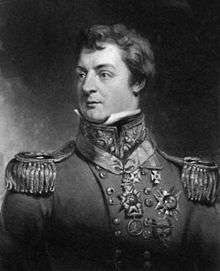Sir James Carmichael-Smyth, 1st Baronet
Major-general Sir James Carmichael-Smyth, 1st Baronet, KCH, CB (22 February 1779 – 4 March 1838) was a British Army officer and colonial administrator.
- This article concerns the colonial administrator. For his father, the Scottish physician, see James Carmichael Smyth (physician)
Sir James Carmichael-Smyth, Bt | |
|---|---|
 | |
| Born | 22 February 1779 London, England |
| Died | 4 March 1838 (aged 59) Georgetown, British Guiana |
| Allegiance | United Kingdom |
| Service/ | British Army |
| Rank | Major-general |
| Battles/wars | War of the Sixth Coalition Peninsular War Waterloo Campaign |
Biography
Early life and family
Carmichael-Smyth was born in London the eldest son of Scottish physician and medical writer, James Carmichael Smyth and Mary Holyland. His younger brother Henry Carmichael-Smyth, would achieve distinction as an officer serving the East India Company and for being the step-father of William Makepeace Thackeray.
Carmichael Smyth married Harriet Morse, daughter of Robert Morse, on 28 May 1816 and they had one son.[1]
Career
He was educated at Charterhouse School and the Royal Military Academy in Woolwich, London before joining the Royal Engineers in March 1795 as a second lieutenant. One of the chief engineering officers of the British Army in Southern Africa between 1795-1808, he then went to Spain under Lieutenant-general Sir John Moore in 1808-9. From 1813-15 he was stationed in the Low Countries and was present at the ill-fated Siege of Bergen op Zoom in 1814 before going on to command the Royal Corps of Engineers & Sappers at Waterloo.[1] Prior to the battle, Smyth had created a plan of the ground that allowed Wellington to place his troops rapidly and advantageously.[2]
In 1818 he was on Wellington's staff at the Board of Ordnance and was made a baronet in August 1821. He was sent by Wellington in 1823 to survey the defences in the Low Countries and the British West Indies and in 1825 to repeat the operation in British North America.[1] He was promoted major-general in May 1825 and, after carrying out some engineering works in Ireland, was made Governor of the Bahamas in May 1829. In June 1833 he was transferred to be Governor of British Guiana, where he had to deal with the problems of the emancipation of slaves [1]
Between 1815 and 1831 He had published eight volumes on the subjects of military engineering, defence, and slavery.
Death
He died of an illness on 4 March 1838 in Georgetown, Guiana.
Notes
- Raudzens 1988
- Dalton 1904, p. 229.
References
- Raudzens, George K. (1988). "Smyth, Sir James Carmichael". In Halpenny, Francess G (ed.). Dictionary of Canadian Biography. VII (1836–1850) (online ed.). University of Toronto Press. OCLC 53361801.CS1 maint: ref=harv (link)
- Dalton, Charles (1904). The Waterloo roll call (2nd ed.). London: Eyre and Spottiswoode. p. 229. OCLC 263174459, 847974743, 558745289.CS1 maint: ref=harv (link)
Further reading
- Vetch, Robert Hamilton (1898). . In Lee, Sidney (ed.). Dictionary of National Biography. 53. London: Smith, Elder & Co. pp. 185–186.
- Saunders, D. Gail (1986). "Personalities: Sir James Carmichael Smyth, 1779–1838". Journal of the Bahamas Historical Society. 8 (1): 22. Archived from the original on 4 March 2009.
| Government offices | ||
|---|---|---|
| Preceded by Lewis Grant |
Governor of the Bahamas 1829–1833 |
Succeeded by Blayney Balfour |
| Preceded by Sir Benjamin d'Urban |
Governor of British Guiana 1833–1838 |
Succeeded by Henry Light |
| Baronetage of the United Kingdom | ||
| New creation | Baronet (of Nutwood) 1821–1838 |
Succeeded by James Robert Carmichael |